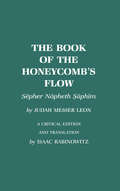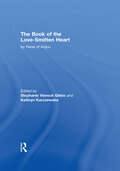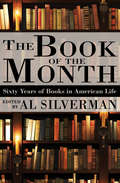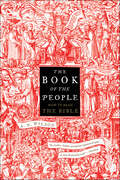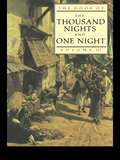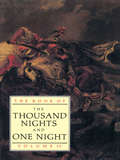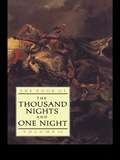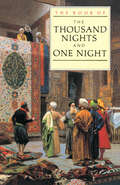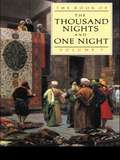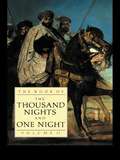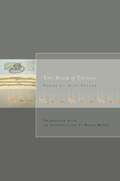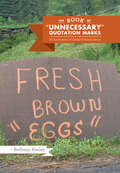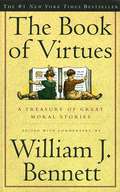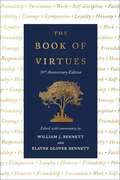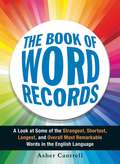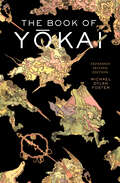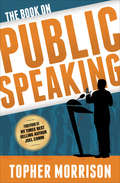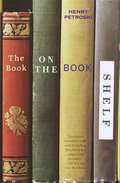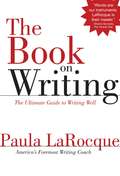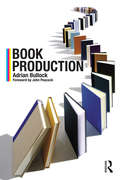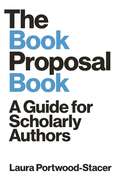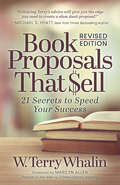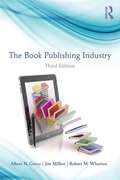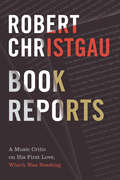- Table View
- List View
The Book of the Honeycomb's Flow: Sepher Nopheth Suphim by Judah Messer Leon
by Isaac Rabinowitz Judah Messer LeonThe Book of the Honeycomb's Flow. Sepher Nopheth Suphim. A critical edition and translation by Isaac Rabinowitz.
The Book of The Love-Smitten Heart (Garland Library of Medieval Literature)
by Rene D'AnjouAvailable only in Middle French and German translation until now, this volume constitutes the first full-length , French-English bilingual edition of Rene of Anjou's Livre du cuers d'amours espris, including all sixteen of the celebrated color plates, a critical introduction, notes on the translation, and a comprehensive bibliography. The book tells the tale of desire and adventure as Heart -- part of Rene torn from his body by Love -- travels a complex allegorical landscape in quest of the lady Mercy, who is being held prisoner by a band of miscreants led by Refusal and Shame. Rene begs the reader to help him determine which of three entities is responsible for his torment: Fortune led him to the lady whom he loves; once he arrived, Love, in the guise of his lady's gaze, struck his heart; and Destiny insists that he reflect upon her alone. In addition to being a compelling courtly page-turner, The Book of the Love-Smitten Heart represents the rare instance in which a medieval love story is told simultaneously in three frameworks: autobiographical letter, dream vision, and quest romance. This structure makes clear the multiple logics within which the author's psychology is reflected in the story, and illustrates how the symbol of the heart, as it travels through these shifting frameworks, dramatizes vital relations linking self, desire, and writing.
The Book of the Month: Sixty Years of Books in American Life
by Al SilvermanThis collection of essays and reviews from the Book-of-the-Month Club offers a unique literary history of American readership in the twentieth century. From The Sun Also Rises to The Accidental Tourist, the judges, editors, and reviewers of the Book-of-the-Month Club help readers all across America find their next favorite book. In this comprehensive anthology compiled from the Club&’s monthly News, astute reviewers praise and critique a diverse array of authors including Dashiell Hammett, Barbara Tuchman, Sinclair Lewis, Saul Bellow, Margaret Mitchell, James Baldwin, Willa Cather, and Evelyn Waugh. Harper Lee affectionately profiles Truman Capote, poet laureate Robert Penn Warren praises his friend Bill Styron, and Gore Vidal interviews himself. John le Carré shares why it was particularly hard to write A Perfect Spy, and E. L. Doctorow reveals the intentions of his masterpiece, Ragtime. A celebration of the life-affirming power of the written word and a treasure trove of reviews, essays, and author portraits related to classic books we all know and love and less famous titles well-deserving of rediscovery, The Book of the Month is a must-read for bibliophiles everywhere.
The Book of the People: How to Read the Bible
by A.N. WilsonFrom renowned historian, biographer and novelist, A.N. Wilson, a deep personal, literary, and historical exploration of the Bible. In The Book of the People, A. N. Wilson explores how readers and thinkers have approached the Bible, and how it might be read today. Charting his own relationship with the Bible over a lifetime of writing, Wilson argues that it remains relevant even in a largely secular society, as a philosophical work, a work of literature, and a cultural touchstone that the western world has answered to for nearly two thousand years: Martin Luther King was "reading the Bible" when he started the Civil Rights movement, and when Michelangelo painted the fresco cycles in the Sistine Chapel, he was "reading the Bible." Wilson challenges the way fundamentalists—whether believers or non-believers—have misused the Bible, either by neglecting and failing to recognize its cultural significance, or by using it as a weapon against those with whom they disagree. Erudite, witty and accessible, The Book of the People seeks to reclaim the Good Book as our seminal work of literature, and a book for the imagination.
The Book of the Thousand and One Nights (Volume #3)
by J. C. Mardrus E. P. MathersFirst published in 1986. Routledge is an imprint of Taylor & Francis, an informa company.
The Book of the Thousand and One Nights
by J. C. Mardrus E. P. MathersFirst published in 1986. Routledge is an imprint of Taylor & Francis, an informa company.
The Book of the Thousand and One Nights (Volume #4)
by J. C. Mardrus Powys MathersFirst published in 1986. Routledge is an imprint of Taylor & Francis, an informa company.
The Book of the Thousand and One Nights
by J. C. Mardrus Powys MathersFirst published in 2013. An unabashed and accurate translation of the wonderful and enchanting tales of the Arabian Nights, complete in four volumes.
The Book of the Thousand and one Nights. Volume 1
by J. C Madrus E. P MathersFirst Published in 1986. Routledge is an imprint of Taylor & Francis, an informa company.
The Book of the Thousand Nights and One Night (Vol 2)
by Powys MathersFirst published in 1986. Routledge is an imprint of Taylor & Francis, an informa company.
The Book of Things
by Brian Henry Ales StegerFrom his first book of poems, Chessboards of Hours (1995), Aleš Šteger has been one of Slovenia's most promising poets. The philosophical and lyrical sophistication of his poems, along with his work as a leading book editor and festival organizer, quickly spread Šteger's reputation beyond the borders of Slovenia. The Book of Things is Šteger's most widely praised book of poetry and his first American collection. The book consists of fifty poems that look at "things" (i.e. aspirin, chair, cork) which are transformed by Šteger's unique poetic alchemy.Translator Brian Henry is a distinguished poet, translator, editor, and critic.From Publisher's Weekly:Steger's efforts sometimes bring to mind such Western European figures as Francis Ponge and Craig Raine, who also sought to make household things look new and strange. Yet Steger brings a melancholy Central European sense of history- his objects tend to remember, or cause, great pain: "It pours, this poisonous, sweet force," Steger writes of "Saliva," "Between teeth, when you spit your own little genocide." (Nov.)From Guernica, a Magazine of Art and Politics:It is a rare treat to have an English translation before the ink has dried on the original. By which I mean, a mere five years after the book's Slovenian publication, Brian Henry has brought these poems to life for those of us not lucky enough to read Slovenian. Henry's translations are impressive for sheer acrobatics.
The Book of Things (Lannan Translations Selection Series #18)
by Ales StegerFrom his first book of poems, Chessboards of Hours (1995), Aleš Šteger has been one of Slovenia's most promising poets. The philosophical and lyrical sophistication of his poems, along with his work as a leading book editor and festival organizer, quickly spread Šteger's reputation beyond the borders of Slovenia. The Book of Things is Šteger's most widely praised book of poetry and his first American collection. The book consists of fifty poems that look at "things" (i.e. aspirin, chair, cork) which are transformed by Šteger's unique poetic alchemy.Translator Brian Henry is a distinguished poet, translator, editor, and critic.From Publisher’s Weekly:Steger’s efforts sometimes bring to mind such Western European figures as Francis Ponge and Craig Raine, who also sought to make household things look new and strange. Yet Steger brings a melancholy Central European sense of history- his objects tend to remember, or cause, great pain: "It pours, this poisonous, sweet force,” Steger writes of "Saliva,” "Between teeth, when you spit your own little genocide.” (Nov.)From Guernica, a Magazine of Art and Politics:It is a rare treat to have an English translation before the ink has dried on the original. By which I mean, a mere five years after the book’s Slovenian publication, Brian Henry has brought these poems to life for those of us not lucky enough to read Slovenian. Henry’s translations are impressive for sheer acrobatics.
The Book of "Unnecessary" Quotation Marks: A Celebration of Creative Punctuation
by Bethany KeeleyFrom the popular blog, a hilarious and horrifying survey of quotation mark abuse in all its forms.From the sarcastic to the suggestive, here are quotation marks as we love them best, doing horrible damage to the English language. Who wouldn’t have second thoughts about ordering the “hamburger” on the diner’s menu? Would it be best to skip the “blowout” sale at the department store? What hidden price must be paid for something marked “free”? Assembled by the creator of the wildly popular “Blog” of “Unnecessary” Quotation Marks, this book surveys the havoc wreaked by quotation marks on signs, menus, placards, and posters that leave reality upended by supposed “facts.” This smarty-pants guide is “perfect” for desperate grammarians, habitual air quoters, and anyone who appreciates a good laugh.
The Book of Virtues: A Treasury Of Great Moral Stories (Book Of Virtues Collection)
by William J. BennettResponsibility. Courage. Compassion. Honesty. Friendship. Persistence. Faith. Everyone recognizes these traits as essentials of good character. In order for our children to develop such traits, we have to offer them examples of good and bad, right and wrong. And the best places to find them are in great works of literature and exemplary stories from history. William J. Bennett has collected hundreds of stories in The Book of Virtues, an instructive and inspiring anthology that will help children understand and develop character -- and help adults teach them. From the Bible to American history, from Greek mythology to English poetry, from fairy tales to modern fiction, these stories are a rich mine of moral literacy, a reliable moral reference point that will help anchor our children and ourselves in our culture, our history, and our traditions -- the sources of the ideals by which we wish to live our lives. Complete with instructive introductions and notes, The Book of Virtues is a book the whole family can read and enjoy -- and learn from -- together.
The Book of Virtues: 30th Anniversary Edition
by William J. Bennett Elayne Glover BennettHelp your children develop moral character with this updated, 30th anniversary edition of the perennial classic Book of Virtues.Almost 3 million copies of the Book of Virtues have been sold since it was published in 1993. It is one of the most popular moral primers ever written, an inspiring anthology that helps children understand and develop character—and helps parents teach it to them. Thirty years ago, readers thought that the times were right for a book about moral literacy. Back then, Americans worried that schools were no longer parents&’ allies in teaching good character. As the book&’s original introduction noted, &“moral anchors and moorings have never been more necessary.&” If that was true in the 1990s, it is even more true today. The explosion of information with the Internet has left many unsure of what is valuable and what is not. Responsibility. Courage. Compassion. Loyalty. Honesty. Friendship. Persistence. Hard work. Self-discipline. Faith. These remain the essentials of good character. The Book of Virtues contains hundreds of exemplary stories offering children examples of good and bad, right and wrong. Drawing on the Bible, American history, Greek mythology, English poetry, fairy tales, and modern fiction, William J. and Elayne Bennett show children the many virtuous paths they can follow—and the ones they ought to avoid. For the 30th anniversary edition, the Bennetts have slimmed down the book&’s contents, while also finding room to introduce such figures as Mother Teresa, Colin Powell, and heroes of 9/11 and the War in Afghanistan. Here is a rich mine of moral literacy to teach a new generation of children about American culture, history, and traditions—ultimately, the ideals by which we wish to live our lives. The updated edition of The Book of Virtues will continue a legacy of raising moral children far into a new century.
The Book of Word Records: A Look at Some of the Strangest, Shortest, Longest, and Overall Most Remarkable Words in the English Language
by Asher CantrellFrom antidisestablishmentarianism to zo, a unrivaled collection of today's greatest words!Have you ever wondered what the longest word in the dictionary is? Or the origin of your go-to curse word?With The Book of Word Records, you'll uncover hundreds of bizarre, ugly, gross, and otherwise extreme words that have what it takes to break some serious records. From the seven longest speeches ever given to twelve of the most popular passwords used today, each of these entries reveals the history behind the world's most noteworthy expressions and fascinating details on how they stack up against the competition. You'll also learn how to step up your vocabulary with pronunciations, definitions, and sample sentences for each award-winning word.Whether you're a Scrabble champ looking to get a high score or just want to impress those around you, The Book of Word Records is sure to surprise even the most skilled wordsmith with its one-of-a-kind superlative lists.
The Book of Yokai, Expanded Second Edition: Mysterious Creatures of Japanese Folklore
by Michael Dylan FosterSignificantly expanded and updated—a lively excursion into Japanese folklore and its increasing influence within global popular culture. Monsters, spirits, fantastic beings, and supernatural creatures haunt the folklore and popular culture of Japan. Broadly labeled yōkai, they appear in many forms, from tengu mountain goblins and kappa water sprites, to shape-shifting kitsune foxes and long-tongued ceiling-lickers. Popular today in anime, manga, film, and video games, many yōkai originated in local legends, folktales, and regional ghost stories. The Book of Yōkai invites readers to examine how people create, transmit, and collect folklore, and how they make sense of the mysteries in the world around them. Revised and expanded, this second edition features fifty new illustrations, including an all-new yōkai gallery of stunning color images tracing the visual history of yōkai across centuries. In clear and accessible language, Michael Dylan Foster unpacks the cultural and historical contexts of yōkai, interpreting their varied meanings and introducing people who have pursued them through the ages.
The Book on Public Speaking
by Topher Morrison&“One of the most powerful professional speakers in America . . . reveals how he&’s earned millions onstage, on camera and in business&” (Steve Siebold, CSP, past chairman of The National Speakers Association&’s Million Dollar Speakers Group). If you look at the trends of over thirty years ago in fashion, technology, architecture, and any other industry, what was cutting edge back then has become cliché and grossly out of date now. But in the speaking industry, most people get up and still walk, talk, and sound like the 1980s motivational speakers of yesteryear. The Book on Public Speaking takes a head-on approach and challenges the status quo for business leaders that speak in front of their staff, board of directors, and the public. After reading this book you will be privy to the most current methods for speaking to an audience for maximum impact in today&’s more sophisticated and skeptical culture. If you are the type of business leader who has achieved a level of success in life and feel compelled to share your story with the world, don&’t lessen that impact by imitating outdated speaking techniques. Instead, break the mold of the speaker cliché and tap into a speaking style that is authentic, packs a punch, and leaves the audience wanting more. &“I learned some amazing presentation techniques from Topher. I&’m using them right now. They&’re awesome. You can&’t tell because you&’re reading this.&” —John Heffron, winner of The Last Comic Standing &“Morrison is crazy good at training you how to communicate on-camera so that your business gets more attention.&” —James Lavers, professional speaker, founder, &“Selling from the Screen&”
The Book on the Bookshelf
by Henry PetroskiFrom the author of the highly praised The Pencil and The Evolution of Useful Things comes another captivating history of the seemingly mundane: the book and its storage.Most of us take for granted that our books are vertical on our shelves with the spines facing out, but Henry Petroski, inveterately curious engineer, didn't. As a result, readers are guided along the astonishing evolution from papyrus scrolls boxed at Alexandria to upright books shelved at the Library of Congress. Unimpeachably researched, enviably written, and charmed with anecdotes from Seneca to Samuel Pepys to a nineteenth-century bibliophile who had to climb over his books to get into bed, The Book on the Bookshelf is indispensable for anyone who loves books.From the Trade Paperback edition.
The Book On Writing: The Ultimate Guide To Writing Well
by Paula LarocqueYou're going to love the way Paula LaRocque teaches in The Book on Writing. A celebrated writing coach with a sense of humor and a gentle touch, she's also a master writer herself with a long and distinguished career in both teaching and practicing the art of writing. The Book on Writing contains 25 chapters in three sections: A dozen essential but easy-to-apply guidelines to good writing, from the importance of clarity to the value of a conversational tone. Paula LaRocque believes learning is easier and more successful when we are not only told but also shown. So her Book on Writing is chockfull of actual writing examples that supplement and illustrate principles that apply as naturally to fiction as they do to nonfiction. How to tell a story from building suspense, to effective description, to the uses of metaphor and literary devices. Paula LaRocque also deals with the narrative engine and the value of the archetype in plotting and characterization as well as with pace and speed and leveling what she terms the speedbumps in writing. A clear and concise handbook that deals with common problems in grammar, usage, punctuation, and style'the kind of problems that often trouble even wordsmiths. The handbook also debunks pesky language rules that are actually myths. The Book on Writing is one-stop shopping for writers. Read it once, and you'll be a better writer. Read it often, and you'll be among the best.
Book Production
by Adrian BullockThe digital revolution has brought with it a wider range of options for creating and producing print on paper products than ever seen before. With the growing demand for skills and knowledge with which to exploit the potential of digital technology, comes the need for a comprehensive book that not only makes it possible for production staff, editors, and designers to understand how the technology affects the industry they work in, but also provides them with the skills and competencies they need to work in it smartly and effectively. This book is designed to satisfy this need. Book Production falls into two parts: The first part deals with the increasingly important role of production as project managers, a role which has not been adequately written about in any of the recent literature on publishing. The second part deals with the processes and raw materials used in developing and manufacturing print on paper products. Case studies are used to illustrate why and how some processes or raw materials may or may not be appropriate for a particular job. With expert opinions and case studies, and a consideration of the practices and issues involved, this offers a comprehensive overview of book production for anyone working, or training to work in or in conjunction with the books industry.
The Book Proposal Book: A Guide for Scholarly Authors (Skills for Scholars)
by Laura Portwood-StacerA step-by-step guide to crafting a compelling scholarly book proposal—and seeing your book through to successful publicationThe scholarly book proposal may be academia’s most mysterious genre. You have to write one to get published, but most scholars receive no training on how to do so—and you may have never even seen a proposal before you’re expected to produce your own. The Book Proposal Book cuts through the mystery and guides prospective authors step by step through the process of crafting a compelling proposal and pitching it to university presses and other academic publishers.Laura Portwood-Stacer, an experienced developmental editor and publishing consultant for academic authors, shows how to select the right presses to target, identify audiences and competing titles, and write a project description that will grab the attention of editors—breaking the entire process into discrete, manageable tasks. The book features over fifty time-tested tips to make your proposal stand out; sample prospectuses, a letter of inquiry, and a response to reader reports from real authors; optional worksheets and checklists; answers to dozens of the most common questions about the scholarly publishing process; and much, much more.Whether you’re hoping to publish your first book or you’re a seasoned author with an unfinished proposal languishing on your hard drive, The Book Proposal Book provides honest, empathetic, and invaluable advice on how to overcome common sticking points and get your book published. It also shows why, far from being merely a hurdle to clear, a well-conceived proposal can help lead to an outstanding book.
Book Proposals That Sell: 21 Secrets to Speed Your Success
by W. Terry WhalinDiscover the Secrets to Getting Published. Writing a book? In the beginning stages of writing a book, most people start with a blank page and write their entire manuscript. According to author and acquisitions editor W. Terry Whalin, this approach is backwards. About 80% to 90% of nonfiction books are sold from a book proposal. This mysterious document called a proposal contains many elements that will never appear in a manuscript—yet these details are critical to publishing executives who make the decision about publishing or rejecting an author’s project. In Book Proposals That Sell, Terry reveals 21 secrets to creating a book proposal that every author needs in order to create one that sells.
The Book Publishing Industry (Mass Communications Book Ser.)
by Albert N. GrecoThe Book Publishing Industry focuses on consumer books (adult, juvenile, and mass market paperbacks) and reviews all major book categories to present a comprehensive overview of this diverse business. In addition to the insights and portrayals of the U.S. publishing industry, this book includes an appendix containing historical data on the industry from 1946 to the end of the twentieth century. The selective bibliography includes the latest literature, including works in marketing and economics that has a direct relationship with this dynamic industry. This third edition features a chapter on e-books and provides an overview of the current shift toward digital media in the US book publishing industry.
Book Reports: A Music Critic on His First Love, Which Was Reading
by Robert ChristgauIn this generous collection of book reviews and literary essays, legendary Village Voice rock critic Robert Christgau showcases the passion that made him a critic—his love for the written word. Many selections address music, from blackface minstrelsy to punk and hip-hop, artists from Lead Belly to Patti Smith, and fellow critics from Ellen Willis and Lester Bangs to Nelson George and Jessica Hopper. But Book Reports also teases out the popular in the Bible and 1984 as well as pornography and science fiction, and analyzes at length the cultural theory of Raymond Williams, the detective novels of Walter Mosley, the history of bohemia, and the 2008 financial crisis. It establishes Christgau as not just the Dean of American Rock Critics, but one of America's most insightful cultural critics as well.
